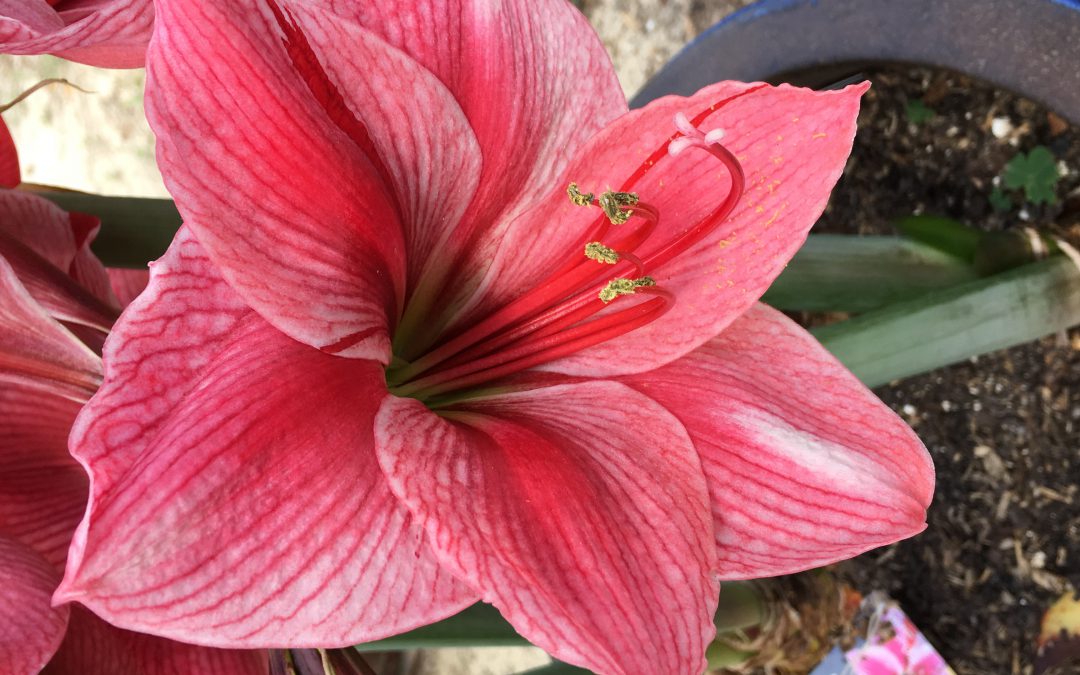
by Logan Boatwright | Apr 16, 2019
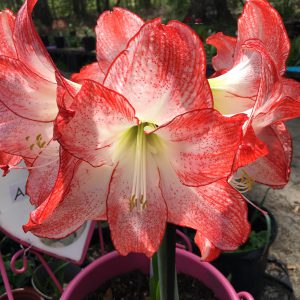
Blooming amaryllis flower. Photo by Logan Boatwright
Are you tired of seeing only green from your shrubs such as boxwood or yew? Are the areas next to your home walls, fences, terraces, tree islands, gate entrances, and/or borders barren? Do you want to add color to these areas? You may want to consider planting these areas with the beautiful amaryllis (Hippeastrum x hybridum).
Amaryllis grows from a tough, dependable bulb that will bloom during the spring after winter dormancy. The strap-shaped leaves will emerge first and grow about 1.5 inches wide, up to three feet long, and persist much of the year in Florida. They are reduced later in the summer and ultimately die back from frost.
In the late winter, bulbs will eventually produce one to three leafless stalks, or scapes, that will each have two or more trumpet-shaped flowers. Flowers come in a variety of forms and shapes: from single and double, miniature or large. Flower colors can be red, bright pink, shades of pink, orange, white, rose, or even salmon. It does not stop there! The flowers may even be striped and multi-colored. Amaryllis can create a striking focal point when they are planted in clusters of 10 or more of similar color.
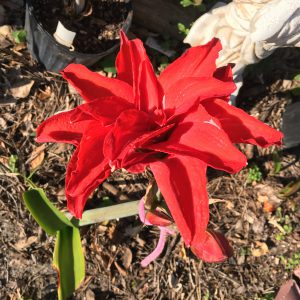
Double flowers of amaryllis. Photo by Logan Boatwright.
Amaryllis may be planted anytime of the year, but winter is best. They are sun- and shade-tolerant, but planting in light shade is best since leaves will yellow in full sun and plants bloom poorly in heavy shade. Amaryllis prefer well-drained sites to prevent bulb and root rots.
For the best amaryllis performance, till and amend the soil with a 3- to 4-inch layer of organic matter and 2 to 3 pounds of 6-6-6, or a comparable amount of other complete fertilizer per 100 square feet. Plant 12 to 15 inches apart. Amaryllis can greatly benefit from at least one fertilizer application in the early spring and two to three applications during the growing season.
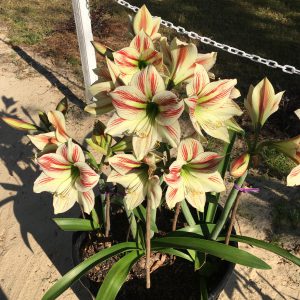
Many blooms from multiple amaryllis bulbs. Photo by Logan Boatwright.
After flowering it’s a good practice to remove the stalks, unless seeds for planting are desired. If the bulbs become crowded, dig and separate them out. Doing this will encourage large, uniform flowers.
Go out, plant a few amaryllis plants today, and be ready to. To learn more about Amaryllis, please follow this link.
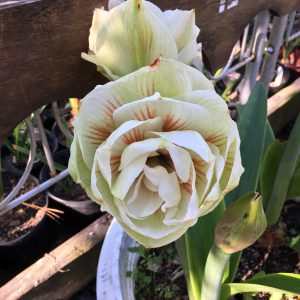
Blooming amaryllis plant. Photo by Logan Boatwright.

by Taylor Vandiver | Feb 17, 2015
Valentine’s Day has come and gone. You were likely showered with gifts from loved ones; gifts covered in chocolate, gifts of the stuffed variety, and more than likely the kind covered in petals. And as you languish in the afterglow of affection it would be wise to remember that your bouquets will need to be shown some affection if you intend for them to remain beautiful.
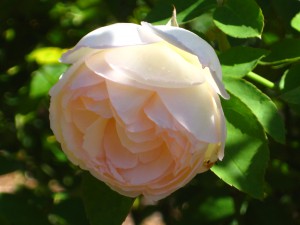
Duchesse de Brabant, Tea Rose. Photo Courtesy David Marshall.
Fresh cut flowers are a popular gift for Valentine’s Day and a simple, yet elegant way to relay your affections. Flowers have the capacity to brighten up a room and bring a smile to your face. The myriad of colors and scents are admittedly irresistible. However, after a few days your once overflowing vase may seem wilted and despondent. Follow these easy steps to increase the lifespan of your flowers and extend their potent powers!

Carefree Beauty, Shrub Rose. Photo Courtesy David Marshall.
- Re-cut the flower stems using a sharp knife or shears. Remove at least one-half inch of stem to expose a fresh surface. Stems, especially rose stems, should be re-cut under water. A freshly cut stem absorbs water freely, so it is important to cut at a slant to avoid crushing the stem and to prevent a flat-cut end from resting on the bottom of the vase.
- Put flowers in water as soon as possible. Maximum water uptake occurs in the first 36 to 48 hours after cutting flowers. Place stems in 100-110°F (38-40°C) water, because warm water moves into the stem more quickly and easily than cold water.
- Make sure to remove any leaves from the stem that may be submerged. Because transpiration through leaves drives water flow up the stems of cut flowers, don’t strip all the leaves from the stem.
- Use a commercial flower food, they work best at controlling microbial populations, hydrating stems, and feeding flowers. Make sure you follow the directions on the floral preservative packet.
- Removing thorns from your roses may shorten their vase life. If damaged during the removal process flowers may be opened up to microbes that could slow down water conducting cells.
- If your vase solution begins to become cloudy, re-cut the stems and place into a new vase solution.
- Do not place flowers in direct sunlight, over a radiator, or on a television set. Heat reduces flower life since flower aging occurs more rapidly in high temperature conditions. It is important to avoid all drafty locations because warm or moving air removes water from flowers faster than it can be absorbed through the stems.
- Keep flowers away from cigarette smoke and ripening fruit, because they contain ethylene gas, which is harmful to flowers.

Louis Philippe, China Rose. Also known as the “old Florida rose” since it is found at many old historic Florida home sites and pioneer settlements. Photo Courtesy David Marshall.









